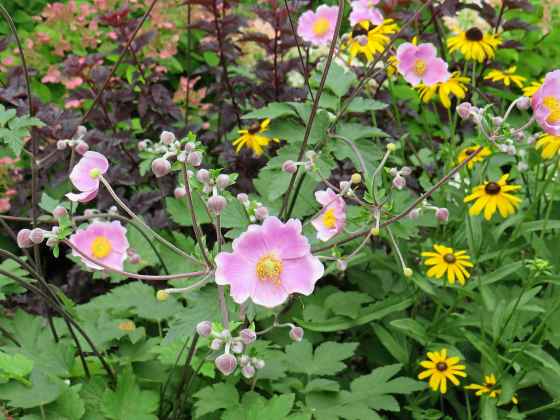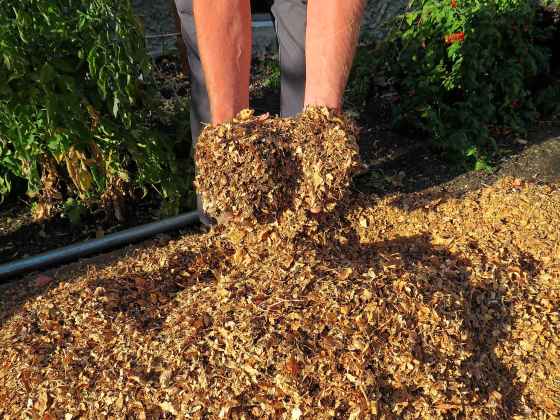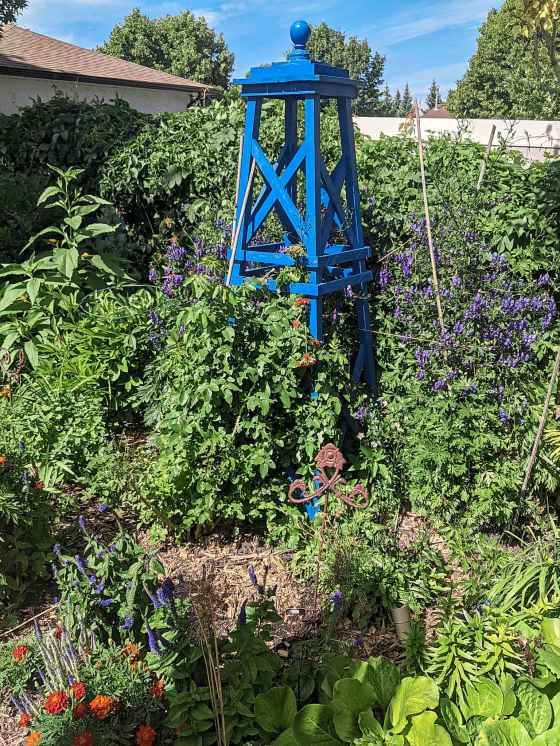Did you find this newsletter on our website? Get it every month in your inbox by signing up here.
September gardening tasks
By taking the time now to do certain tasks such as dividing plants or transplanting while the soil is still warm, you will be saving time next spring. September is also a great time to assess your garden and the plants you grew this year. Make a list of which perennials and annuals really worked for you and which ones didn’t.
You may even want to switch out some plants altogether or prepare a new flower bed for next year. I have fallen in love with Grape-Leaf Anemone ‘Robustissima’ and plan to dig up a swath of thyme this fall so I can make room for more anemone. Fall is a wonderful time for completing unfinished projects and making new plans.

Grape Leaf Anemone Robustissima (Colleen Zacharias / Winnipeg Free Press)
Be sure to collect and save your leaves. Shredded leaves are excellent for placing around tender plants that need some extra protection during winter.
Once leaves start to dry and become crispy, mow over them with your lawn mower to shred them. I always store leaves over winter for use next summer as a mulch around plants when temperatures are sizzling.
Leaves are rich with nutrients. As the leaves decompose, the nutrients are recycled into the soil by beneficial soil microbes. You will see the difference in the texture of your soil!

Shredded leaves are great for use around the garden. (Colleen Zacharias / Winnipeg Free Press)
Got aphids?
Many local gardeners have been reporting legions of yellow aphids on the stems and leaves of their milkweed plants this year.
Aphids come in assorted colours – red, yellow, black, green, and sometimes, white or brown. The yellow aphids are non-native. They have piercing-sucking mouthparts that extract plant sap. Ladybugs devour aphids, but where are enough ladybugs when you need them?
Typically, an infestation of aphids on most perennials can be safely removed by using an insecticidal soap or spraying plants with a strong blast of water from your garden hose to knock the aphids to the ground, where they will be eaten by ground-dwelling insects.
In the case of milkweed, gardeners are faced with a conundrum. Milkweed is the only source of food for the caterpillars that become Monarch butterflies. A blast of water might dislodge eggs or knock caterpillars to the ground. Spraying with an insecticide would cause much more harm than good.
The safest method is to remove the clusters of aphids from milkweed by hand. They are bright yellow so you can’t miss them.

Hordes of yellow aphids are seen on a milkweed plant, with a lady bug to the rescue. (Susan Southern photo)
Aphids overwinter, so start planning your battle for next year. Beneficial insects such as ladybugs are available for pre-order as early as December at some local garden centres. Pick-up is usually in June or July.
Whether you choose to control aphids with beneficial insects, hose spraying, or hand removal, don’t wait until aphid populations explode. Control measures should start at the first sign of the presence of aphids. Aphids can reproduce asexually, so if left to their own devices they can be a formidable foe.
If you apply fertilizer to your garden in spring, avoid fertilizing your milkweed plants if you are using a high-nitrogen fertilizer. A fertilizer with high nitrogen content can cause plants to be more susceptible to aphid infestations.
Planting trees and shrubs
Cheyenne Gittins is the tree and shrub manager at Lacoste Garden Centre. One of the questions she is asked frequently is whether trees and shrubs can be planted in fall.
“Absolutely,” says Gittins. “In fact, fall is an ideal planting time because the soil is still warm and easy to dig. There is also less heat stress on plants.”
Ensure adequate moisture so that newly planted trees and shrubs go into the winter well-watered.
Did you find this newsletter on our website? Get it every month in your inbox by signing up here.
Composting in fall and winter
The best time to add compost to your garden beds is in the autumn, says Kristen Malec at the Green Action Centre.
“Even though your compost may seem finished and ready to use, it may not be fully cured,” says Malec. “If you harvest your compost and put it into a pile in your garden or spread it on your perennial and shrub beds or around the base of your trees, your compost will fully cure over the winter.” In addition, by putting down compost in fall, it’s one less thing to do next spring.
When is the best time in fall to add compost to your beds? Malec says there is no special time. Do it whenever it is convenient! Just spread the compost directly onto your soil surface, there is no need to till it into the soil.
Tips for winter composting: By emptying your compost bin and spreading your compost, you will have space for the organic waste that you collect during winter, says Malec. Winter compost freezes in compost bins and takes up extra space. “When spring comes, the compost thaws and breaks down quickly.”
If your backyard compost bin is not easily accessible in winter, place a five-gallon plastic container in your kitchen and line it with newspaper. Once the container is full of organic waste, wrap the compost in the newspaper similar to a burrito. “Put the compost burrito outside your door in a larger container that has a lid,” says Malec. “Keep filling it up. It will freeze quickly and once the outside container is filled, empty it into your larger compost bin or you may even want to wait until spring.”
No compost bin? Do you live in a condo or apartment and would like some assistance with composting? A compost courier is here to help you! For a fee, a compost courier provides you with a bin and once it is filled, a courier picks up the organic waste for composting at the Prairie Green Landfill.
An added bonus is that meat or compostable plastic can be added to the bin, which is not something homeowners who compost in their yards can easily do since temperatures do not get hot enough in a home bin. Compost courier is a social enterprise that helps to support Green Action Centre. Businesses, schools, and community organizations can also take advantage of this service. For more information, contact Compost Winnipeg.
Mark your plants
It’s exciting each spring when we discover which new plants survived their first winter in our gardens. Plant markers make it easy to identify plants in the spring when new green growth starts emerging.
Heavy snow can sometimes dislodge plastic plant tags. Consider making your own plant markers from pieces of scrap wood. A plastic milk carton can be used to make several plant markers. Use a permanent marker. If you want to purchase plant markers, consider zinc metal, which won’t rust.
Mark your calendars
The first Saturday of October is a busy one for gardeners, with three notable events:
Manitoba Regional Lily Society Fall Bulb Sale, Oct. 1st: The first in-person MRLS Fall Bulb Sale since 2019 will take place at T&T Seeds, 7724 Roblin Blvd., Headingley. The sale is open to the public from 9:00 a.m. to 3:00 p.m.
There will be a great selection of Asiatic, Martagon, LA (Longiflorum x Asiatic), OT (orienpet), and species bulbs from various suppliers in Manitoba and across Canada. There will also be a mail-order opportunity for people who reside outside of Winnipeg who can’t make it to the sale. For more details as well as a list of bulb varieties, visit the MRLS Facebook page.
Roland Pumpkin Fair, Oct. 1 at the Roland Arena, 36 South Ave., in Roland: Giant pumpkins, beets, tomatoes, beans, and other produce will be on display. For more information, contact Sara Peters at rolandcraftshow2022@gmail.com.
Free Press Fall Supper: also Oct. 1 at 5 p.m. at the Ukrainian Labour Temple, 591 Pritchard Ave., in Winnipeg. A multi-course menu inspired by the recipes in the paper’s forthcoming community cookbook, Homemade: Recipes and Stories from Winnipeg and Beyond. See more details and buy tickets on Eventbrite, and find out more about the cookbook here.

The second Free Press Fall Supper takes place Oct. 1.
Did you find this newsletter on our website? Get it every month in your inbox by signing up here.
Your questions, answered
Have a question for a gardening expert? Email us and we’ll seek answers from some of Manitoba’s most knowledgeable gardeners.
Question: I purchased a John Cabot climbing rose about five years ago. The first year or two I had very few blooms, so I moved it to a sunnier, south-facing location where I believe it is getting at least six hours of light every day. However, while the leaves are abundant, I haven’t had a single bloom since moving it.
Last year I fertilized with rose fertilizer and bone meal, but saw no blooms. This year I did not use any fertilizer, thinking perhaps that might be the problem. I just added compost. Still no blooms. Any advice for this novice gardener would be appreciated! –Helen

Helen’s John Cabot climbing rose has lush foliage but no blooms.
Answer: It was a good idea to move your rose to a sunnier spot, which should be ideal. You may just have to be patient, because it takes a year or two for a newly planted rose to settle in and start blooming. And this one had to settle in twice!
The size seems to say it is getting enough moisture and growing well, so perhaps it will bloom next year.
Once a rose is producing leaves, its greater need is not for nitrogen (N), which promotes green growth, but for phosphorus (P) and potassium (K) to promote bloom. Although compost is an excellent supplement, it has a fairly low N-P-K ratio of around 1.5-0.5-1.0 percent by weight. Bone meal, at around 4-10-0, is good for adding phosphorus, but it is absorbed slowly.
If you want to try prodding your rose into bloom, wait until next spring and apply your rose fertilizer (likely 18-24-16) or a balanced fertilizer (e.g. 20-20-20). Do not apply it now, as it will prompt soft new growth that will not harden off properly for winter.
Some specialists recommend using a little water-soluble fertilizer with each watering. Others recommend three feedings of granular fertilizer per summer, ending in early August.
— Manitoba Master Gardener Association
“Please admire my plant!”
Got a fabulous flower blooming in your garden? A handsome houseplant? A ravishing radish or elegant eggplant? An attractive annual or pulchritudinous perennial? We want to see it.
Send your submission to us and we’ll feature your gorgeous growth in future issues of this newsletter. Please include a photograph, the name of the plant, your name and any details our readers might want to know about it. Please submit a photograph only if you took it yourself.

A hummingbird sips nectar from a flower in one of the gardens near the Riding Mountain National Park Visitor Centre in Wasagaming. Hummingbirds were busy fighting over flowers and filling up for their coming migration south. (Tim Smith / The Brandon Sun)
Did you find this newsletter on our website? Get it every month in your inbox by signing up here.
|

